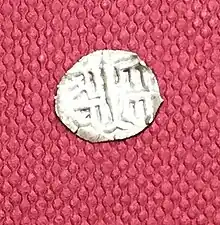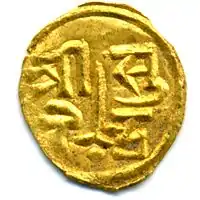Dam (Nepalese coin)
Dam was a small coin, either silver, gold or copper first minted during between c. 1098 - 1126 CE., replacing old Licchavi coinage.

History
First introduced by King Sivadeva during his between c. 1098 and 1126 CE., replacing old Lichhavi coinage. In the new system Gold Sivaka, Silver Dam and later Nava-Dam-Sivaka and copper Dam were introduced as a new denomination.[1]
Types
Originally Nepali Dam, were made of 1 g pure silver or copper, but Later minting of copper Dam was discontinued in the Malla period and dam started getting smaller and smaller up-to 0.04 g.[2] Copper Dams were reintroduced during Shah era but was only used in other Hill and Terai region of Nepal as tiny silver dams were preferred by the locals of Kathmandu Valley.
In popular culture
Watch Your Language lists the coin as one of the possible sources for the English phrase "I don't give a dam[n]″, due to its small worth, but provides other sources as well.[3]
Gallery
 Silver Dam Girvana Yudha compared to US cent.
Silver Dam Girvana Yudha compared to US cent. Girvan Yudha Copper Dam in Arabic Script
Girvan Yudha Copper Dam in Arabic Script Gold Dam of Surendra
Gold Dam of Surendra
See also
References
- Nicholas G. Rhodes; Karl Gabrisch; Carlo Valdettaro Pontecorvo della Rocchetta (1989). The coinage of Nepal from the earliest times until 1911. Royal Numismatic Society. ISBN 978-0-901405-27-2.
- Joshi, Satya Mohan (1961). Nepali Rashtriya Mudra (National Coinage of Nepal). OCLC 652243631. Archived from the original on 30 November 2016. Retrieved 30 November 2016.
- Gorrell, Robert, Watch Your Language: Mother Tongue and Her Wayward Children, University of Nevada Press, 1994. Watch Your Language at Google Books